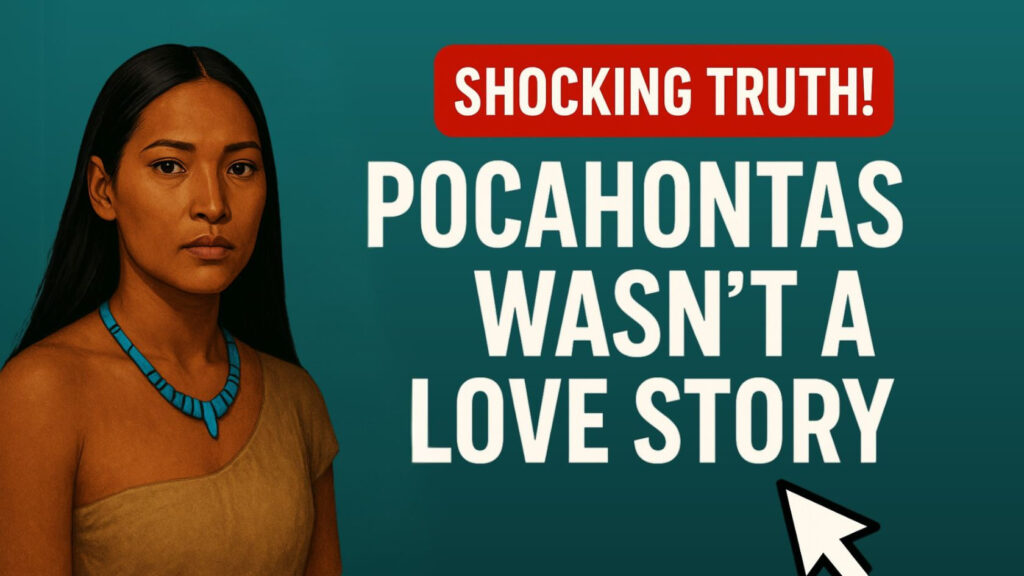 In the churn of online content, few names from early colonial America generate as much traffic as Pocahontas. Social media headlines promise shocking truths or secret histories, usually paired with nostalgic imagery or dramatic music. Some are educational. Many are cynical engagement traps. And more than a few quietly reinforce revisionist myths under the guise of revelation.
In the churn of online content, few names from early colonial America generate as much traffic as Pocahontas. Social media headlines promise shocking truths or secret histories, usually paired with nostalgic imagery or dramatic music. Some are educational. Many are cynical engagement traps. And more than a few quietly reinforce revisionist myths under the guise of revelation.
But the truth is not romantic. It’s not harmonious. It’s not even ambiguous.
What happened to Pocahontas was a kidnapping, a forced conversion, and the exploitation of a child by a colonial empire.
From Matoaka to Myth
Born around 1596, Pocahontas’s real name was Matoaka. “Pocahontas” was a nickname—likely meaning “playful one.” She was the daughter of Wahunsenacawh, the paramount chief of the Powhatan Confederacy in what is now Virginia.
She was likely just 10 or 11 years old when the English established Jamestown in 1607. The oft-repeated tale in which she saved John Smith from execution didn’t appear in any of Smith’s early writings—it was added years later, after she had become famous in England and could no longer contradict him. Historians widely believe the scene, if it happened at all, was part of a ritual Smith misunderstood or deliberately embellished.
That story, and its many retellings, became the foundation for a national myth: that colonization was noble, mutual, and even romantic.
The Real Story
In 1613, during ongoing hostilities between the English and the Powhatan people, Pocahontas was abducted by English Captain Samuel Argall. She was taken as a hostage to force her father’s cooperation.
During her year of captivity, she was isolated, indoctrinated, and baptized under the name Rebecca. Her forced conversion and cultural erasure were presented as spiritual salvation.
In 1614, she was married to tobacco planter John Rolfe. The marriage was politically motivated and deeply unequal—a colonial tactic disguised as diplomacy. Rolfe himself described the union not in terms of affection but as a strategy to “advance the good of the plantation.”
The Trip to England and Her Death
In 1616, Pocahontas was taken to England by the Virginia Company to promote their “success” in civilizing Indigenous peoples. She was dressed in English clothes, paraded through court, painted in oil, and introduced to royalty—not as a person, but as proof of concept.
She died in 1617, at around 20 or 21 years old, just as she prepared to return home. The cause was likely smallpox, pneumonia, or tuberculosis. She was buried in Gravesend. The exact location of her grave is lost.
The Clickbait Afterlife
Today, Pocahontas lives on in viral videos, hashtag threads, and simplified classroom slides. She’s used to sell everything from cultural nostalgia to political agendas. Some creators mean well. Others are clearly monetizing tragedy.
In some circles, she’s portrayed as a Christian heroine. In others, a princess. In still others, a victim of a global conspiracy. Very few portrayals center what she actually was: a young girl, trafficked across an ocean, held up as a symbol of peace while her own people were systematically displaced and destroyed.
Even the better-intentioned online narratives often flatten the story to a single twist ending: “She didn’t marry John Smith!” As though correcting that one myth unlocks the rest of the truth.
It doesn’t.
Why It Still Matters
This is not just a question of historical accuracy. It’s a question of power.
Pocahontas’s story is still used to soften the brutality of American colonization. Her name is invoked in politics, branding, and entertainment as a symbol of innocence and integration. The real events—her abduction, forced conversion, marriage under duress, and early death—are tidied away to preserve the fiction.
What she endured wasn’t a storybook romance. It was a case study in cultural conquest. And remembering her honestly is one small act of resistance against the machinery that turned her life into content.

